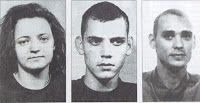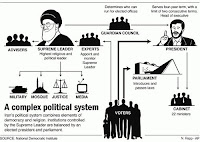B.A.F (“Brown” Army Faction) !

Jana Hensel wrote for the Guardian the following article:
“We still don't know a lot about the three rightwing radicals from Thuringia: Beate Z, Uwe M and Uwe B. I try to see it like this: if I had come from the countryside and not from the town, had not only my father but my mother too crashed and burned after reunification, had the tough kids in my school tied up their combat boots with white laces instead of red laces, had their older brothers and sisters beaten up foreigners at bus stops instead of occupying houses in Leipzig-Connewitz and opening galleries – maybe I too would have been on that slippery slope that in most cases starts off harmlessly enough, but can end in disaster all the same. And now 10 people have been killed.
I cannot shake the feeling that little more than a very thin line in my CV separates me from the three violent neo-Nazis. They're about my age. And life in eastern Germany in the mid-90s was rough, cynical and nonstop – as if the lethargy, futility and hypocrisy of the 80s in the GDR, together with the disappointments of the reunification period, had found bodily form in us as adolescents.
Still a student, after the fall of the wall you had to decide whether you were "left" or "right". Nothing more sensible was about. That's how we dressed, chose what bars and clubs we went to, the demonstrations we took part in: left or right. You knew the ones on the other side, from the lower classes, from the sports club, a son or daughter of a former colleague of your parents. Have you heard, he's one too? That's how it was. You knew someone who had stolen a car, set fire to a vacant house, peddled drugs, kept a weapon stashed under the bed. The Leipzig-based writer Clemens Meyer depicted this era well in his novel Als Wir Träumten ("When We Were Dreaming"), which was praised by critics for its portrayal of the so-called underclass. In truth, many of us were there. It has little to do with the underclass; more with the feeling of being lost, which was stronger than the feeling of being an individual.
The more innocent among us moved to the inner city and stole clothes or bicycles. That was just going through puberty. But it can get to a point where you lose all proportion. In September 1997, the trio, who were still living in Jena, planted their first bomb. In front of the local theatre police found a pipe bomb filled with 10g of TNT. Only the detonator was missing.
It's odd that this simple story of drift is not being told now. Odd that it's not being asked: under what conditions could young people be so radicalised that calling them an "underground" seems legitimate? These questions, however, would point to the heart of a debate on East Germany that we've grown increasingly tired of over the years. It's already gone wrong so often. Instead of open and critical soul-searching in both parts of the country, recriminations flew, east against west, back and forth: it was more about ideologies than biographies, and in it always hovered a whiff of racism based on ethnic origins. Just think back to the false alarm of Sebnitz in 1997, when a six-year-old half-Iraqi boy was allegedly drowned by skinheads in the public baths of Sebnitz, an eastern town. It later transpired that the testimony of witnesses was false and the death an accident. Reporters just hadn't researched the story properly.
Now, what has clearly come to light about the "Zwickau cell" is becoming taboo. One no longer asks why nine out of 10 victims shot to death were in the area of the former Federal Republic (West Germany), and whether this was more than just a coincidence.
Instead, the debate is over the failures of the security authorities. That must be cleared up, for sure. But haven't the teachers, the parents, the friends, the politicians, the institutions all failed? Can it not also be asked, equally fairly: at what point, at what time did we lose these children? Children that we were glad to think belonged to the generation that came out winners from German reunification.
But with the phrase "Brown Army Faction", a name has already been slapped on them, a label that shuts down the real debate before it can start. The East German neo-Nazis now appear as children of a West German movement – the Red Army Faction, also known as the Baader-Meinhof group – which they have no link with whatsoever. The Brown Army Faction label is no accident, but much rather reveals, yet again, the same old point of view. It's still the history of the old Federal Republic that thrusts itself into the centre of attention and sets the standards for comparison.
The history of the Red Army Faction, which now steps forward in a kind of renewed escalation, is permitted to repeat itself only as a "brown" variant (a Nazi uniform reference). But is it really a generational conflict that underlies the group's violent acts? Does it separate the West German post-war parents from the East German reunification parents much more than it brings them together?
We won't get answers to any of these questions if we don't slowly start to buy into the idea that East Germany has its own history, which starts before 1989 and is about more than just reunification. When we start to tell this story too, we start to establish new social and political realities. That would be the opposite of "underground". “



Comments